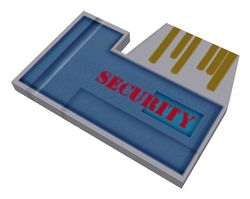Security card
| The contents of this article have been cut. | ||
|---|---|---|
The subject matter of this article contains in-development information that was cut from the final version of an official and/or canonical source and appears in no other canonical source. It may also contain incomplete information since not all cut material is publicly known. |

| |
| Security card | |
|---|---|
| General information | |
| Faction | |
| Type |
Card |
| Usage | |
| Used by | |
| Game information | |
| Entity |
item_security |
The security card,[1] also known as the security keycard,[2] is an item cut from Half-Life.
Contents
Overview[edit]
Security cards were to give the player access to doors locked with a card reader in the Black Mesa Research Facility. They were likely to be picked up in offices or on the dead bodies of Black Mesa personnel.
Appearances[edit]
In the Half-Life Alpha, security card readers can be found throughout the levels. Although no security cards are present, they're mentioned in the walkthrough for the game. In the chapter Communications Center, the player was required to kill a security guard and take his card to gain entry to previously inaccessible rooms.
Behind the scenes[edit]
The security cards were cut late in the development. In a screenshot from September of 1998, a card can be seen next to a dead security guard. The card's model can be found in the files in the final game. The card readers were to use the buttons/button9.wav beeping sound file which is described as "keycard sound".[1] The card reader's texture is used in the final game for generic buttons.
In other media[edit]
The security card model was recycled for Team Fortress Classic map Rock 2. In this appearance, they're team-colored and feature four new skins for each team.
Gallery[edit]
Half-Life Alpha[edit]
A card reader in The Portal Device.
Half-Life (pre-release)[edit]
A card in Unforeseen Consequences.
A card reader in Office Complex.
Other[edit]
An unusable card reader in Santego Military Base.
References[edit]
- ↑ 1.0 1.1 Half-Life game data file (
halflife.fgd) - ↑ Half-Life SDK





